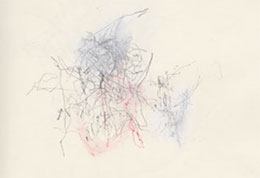A practice-based research fine art collaboration
04 May 2016
'Touching the World Lightly' is the result of work emerging from a creative partnership between Duncan Bullen, Principal Lecturer and Academic Programme Leader for Fine Art and Jane Fox, Senior Lecturer on Fine Art Printmaking and Performance and Visual Art.
Both Bullen and Fox collaborate with the wider environment and its properties in their research-based practice. They seek to establish a space in which the fragility, loss, vulnerability and interconnectedness of human and landscape, animate and inanimate things, can be productively reflected upon. In doing this they ask whether art-making can take account of and tend to these conditions and, implicitly, they draw attention to the debates around ‘wellbeing’. As researchers they are interested in the transformative powers of making art as an act of partnership. In this, the processes of art-making are foregrounded and the individual artist’s volition is de-centred. Through touch and an engagement with all the senses, both artists explore intimate and reciprocal relationships with the world. Facilitated by Research Fellow Dr Philippa Lyon, the team project has emerged in part from the College’s Drawing Research Interest Group (DRIG) and partly through a developing relationship with ONCA Gallery in Brighton. Lyon, using a combination of methods, will conduct a process of narrating, documenting and analysing Bullen and Fox.
Fox’s practice research throughout the project. These will include interviews, a research journal incorporating images and reflections on the creative process from the three researchers’ perspectives and related theoretical explorations.
Bullen, Fox and Lyon are currently developing bids for internal and external funding. If successful, these will lead to an exhibition titled Touching the World Lightly, related educational and community workshops and a research publication. The project emerges in part from the experience of co-curating the This is Change exhibition at ONCA in December 2015, which featured a number of Brighton staff and students.
JANE FOX
‘Two kinds of line did seem to stand out from the rest, and I called them threads and traces. Yet on closer inspection, threads and traces appeared not so much categorically different as transforms of one another. Threads have a way of turning into traces, and visa versa. Moreover, whenever threads turn into traces, surfaces are formed, and whenever traces turn into threads, they are dissolved.’
Ingold, T. (2007) Lines: A Brief History, Routledge
The wind drawings originally came about by way of setting up and physicalizing a space of contemplation, in response to Tim Ingold’s notions of ‘threads and traces’.
The ingredients for the drawings are: body (as lived experience, receiver/resonator), paper (the site for transition from thread to trace and back again), mark-making tool (dispenser of threads) and wind (the kinetic agent to activate the site). In this approach to drawing, the paper is held into the wind. The repeated contact and break builds up ‘traces’ on the surface, alongside an intensity of ‘threads’ in the space between surface and hand.
In the context of the temporal nature of performative acts, the wind drawings can be seen as holding ‘traces’. It is, however, in rela- tion to ‘threads’, made visible only whilst the drawing is in action, that Fox contemplates her own practice interests; the processes of bringing to bear, giving voice to, or making visible.
It is this aspect to the work that has allowed Fox to continue to develop the drawings as part of her project, The Mourning Stone. This is a development of her research interest in ‘walking as process’ and addresses the need to create a space for reorientation in the face of grief and loss.
DUNCAN BULLEN
‘While lines demarcate and define objects, they also assemble and connect ... Lines express the ways in which things act upon one another and upon us; the ways in which, when objects act together, they re-enforce and interfere.’
Dewey, J. (2009) Art as Experience, Perigee Books
In this work, Bullen is dealing with an intimate relationship to the world both as something external and internal; how the world touches us, and how we touch the world. It proposes an intimate engagement through drawing that allows us to experience the objective and the emotional, not as separate realities but as entities that are thor- oughly and deeply entwined.
The work develops Bullen’s interest in how the practice of drawing and the practice of mindfulness may, through certain processes and procedures, inhabit similar mental space. For Bullen this involves find- ing ways to slow down the making process, allowing him to explore graphic, meditative and sensory possibilities through the elementary activity of making one mark after another in repeated sequences.
In order to make each ‘breath’ drawing, Bullen laid paper onto uneven surfaces and drew each line on the in-breath, as one might count in meditation. To draw a straight line was not in his grasp because of the resistance and disruption of the uneven ground on which the paper was placed. Consequently, each line became a record of the moment of its making. The lines explore the productive tensions between rational measure or agency and the surrendering of agency to chance.
Bullen shows how touch is foregrounded by the fragility of the drawn mark. His collaborative approach involves focusing and responding to what particular materials bring and requires a light- ness of touch, or a kind of ‘listening’. In this way the qualities of the joint endeavour can emerge and be valued: for example, the willing- ness to allow and cultivate receptivity and trust in the results as they unfold. It is through the meditative nature of this art practice that ideas of ‘wellbeing’ meet with the practice and ethics of mindfulness and emotional articulation.
